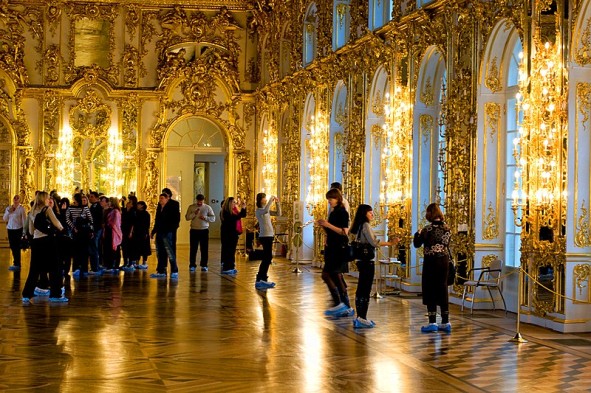Palaces Are Known For Both Tattletales And Wagtails
Dr. James J. S. Johnson
Curse not the king, no not in thy thought; and curse not the rich in thy bedchamber: for a bird of the air shall carry the voice, and that which hath wings shall tell the matter. (Ecclesiastes 10:20)
Royal palaces are known to attract (and to house) some of God’s winged wonders, and Catherine’s Palace — one of the imperial Russian palaces — is no exception. (And not all palace-dwelling birds there are tattle-tales, although some are wagtails!)
Catherine’s Palace, front entrance exterior (Saint-Petersburg.com photograph)
Catherine’s Palace is a royal mansion – a “summer palace” — in Pushkin (a/k/a Tsarskoye Selo), about 19 miles south of St. Petersburg (f/k/a Leningrad), Russia, which my wife and I visited on July 9th of AD2006. The imposingly-humongous-yet-flourishingly-ornate, embellishment-heavy, exquisitely dignified architecture is classified as Rococo (i.e., late Baroque), and a ton of wealth is built into its many construction details and decorative displays. The palace was originally commissioned by Empress Catherine I (AD1717) but was extravagantly modified (during AD1752-AD1756) at the direction of Empress Elizabeth Petrovna, Catherine’s daughter (who was 1 of Catherine’s 2 children who survived to adulthood, the other 10 dying young), and afterwards by Emperor Alexander I, Catherine’s grandson. Before German invaders destroyed the palace’s interior, during World War II, Russian archivists had documented the interior of the palace; those records were used (after the war) to repair and restore some, but not all, of this historic and opulent mansion.

Grand Hall, Catherine Palace, in Pushkin, Russia (Saint-Petersburg.com photograph)
Yet one of the most magnificent treasures, of Catherine’s Palace, survives to this very day — hidden in plain view — skipping merrily in the yards and fields adjacent to Catherine’s Palace: the WHITE WAGTAIL.

WHITE WAGTAIL 1st summer female (Andreas Trepte / Wikipedia photograph)
The White Wagtail (Motacilla alba), a mostly grey bird (of a grey tone similar to that of many mockingbirds) with a black head (and bib) that contrasts with white “eye-mask” plumage, plus blue and white striping on its wings and tail-feathers. This small black-white-and-grey passerine, cousin to the pipits, is named for its most famous behavior: wagging its tail.
Slim black and white bird with a long, constantly wagging tail. Frequently seen beside water but equally in fields, farmyards, parks, [recreational] playing fields, roadsides, rooftops. The [subspecies variety called the] Pied Wagtail (race yarrellii) is resident [of the] British Isles, although a very few nest on adjacent continental coasts. Nominate White (race albus) nests throughout Europe [from the Iberian Peninsula to the Ural Mountains, including the Baltic Sea coastlands including Russia’s St. Petersburg – but only summering in the northern half of Europe], and is scarce but regular passage migrant to Britain (March-May / August / October).
[Quoting Chris Knightley, Steve Madge, & Dave Nurney, POCKET GUIDE TO THE BIRDS OF BRITAIN AND NORTH-WEST EUROPE (London & New Haven, Yale Univ. Press, 1998), page 201. See also, accord, Lars Jonsson, BIRDS OF EUROPE, WITH NORTH AFRICA AND THE MIDDLE EAST (Princeton University Press, 1993), page 372-373.]

WHITE WAGTAIL (Bengt Nyman photograph)
For me, the Wagtail’s characteristic tail-wagging reminds me of a happy pet dog, such as a French Poodle or Labrador Retriever. Every child should have happy memories of a happy dog’s companionship – I’m thankful that my childhood memories include such happy times. Wagtails themselves enjoy their own version of companionship; they are monogamous, sharing nest duties (e.g., constructing the nest together, taking turns to incubate their unhatched eggs, and taking turns feeding the hatchlings), and they defend their own family’s territory.

WHITE WAGTAIL with insect prey (Roy & Marie Battell / Moorhen.me.uk photograph)
What do wagtails eat? A mix of adult and larval insects (e.g., flies, midges, cranflies, mayflies, caterpillars, moths, dragonflies, beetles, aquatic insect larvae), spiders, earthworms, tiny fish fry (as it wades in shallow water), a few seeds, and sometimes small snails.

WHITE WAGTAIL male in shallow water (Ivan Sjögren photograph)
The White Wagtail also bobs his head while walking, somewhat like how city-dwelling pigeons do.
Walks or runs [sometimes making quick dashes] with nodding head, sudden lunges and flycatching leaps. In flight, can be picked out at distance by long tail and conspicuously dipping action, with distinct bursts of wingbeats. Flight call characteristic: a loud tchiz-ick; also utters an emphatic tsu-weeI. Lively, twittering song. In winter, forms large roosts in reedbeds, towns, etc.
[Quoting Chris Knightley, Steve Madge, & Dave Nurney, POCKET GUIDE TO THE BIRDS OF BRITAIN AND NORTH-WEST EUROPE (London & New Haven, Yale Univ. Press, 1998), page 201.]
So, if you ever get to visit Catherine’s Palace, in Pushkin (outside of St. Petersburg), Russia, as we did on July 9th of AD2006, do enjoy all the golden glitter and ivory opulence — but don’t forget to also keep an eye open for a bird wagging its tail, maybe foraging on the manicured lawns nearby, or hunting near other less glamorous buildings — you might see an avian treasure, the White Wagtail! ><> JJSJ profjjsj@aol.com

WHITE WAGTAIL hunting rooftop insects (Roy & Marie Battell / Moorhen.me.uk montage photo-blend)


What a fascinating article and like kkessler, the photos are superb.
LikeLike
Thanks, Lee. Russia (especially the area in and near St. Petersburg) is a very unusual country.
LikeLike
The photographs only hint at how elegant Catherine’s Palace is — and now I’ve added an aerial view of he palace complex. When we visited, in AD2006, the onion dome assembly was under construction.
LikeLiked by 1 person
Beautiful piece re. Wagtails – and beautiful palace with gold so numerous – thanks for writing this – love the wagtail and it does remind me of a sweet pet dog who is so happy.
LikeLiked by 2 people
Such beautiful photographs!
LikeLiked by 2 people
Also saw these same birds (i.e., White Wagtail, a/k/a Pied Wagtail) in Scotland, during mid-to-late July of AD2019.
LikeLiked by 1 person
Great!
LikeLike